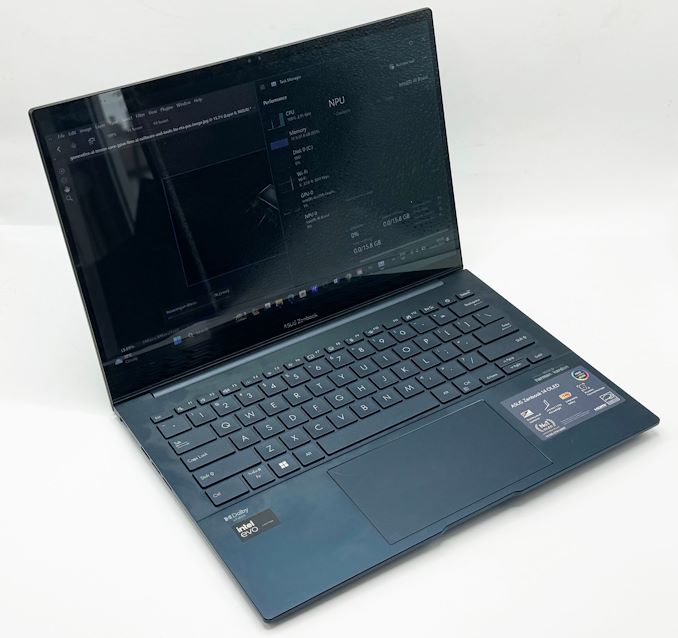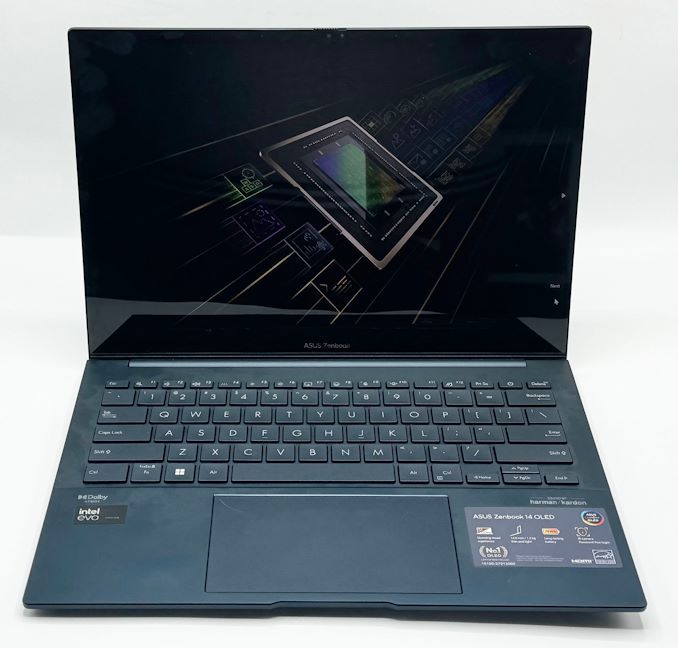The Intel Core Ultra 7 155H Review: Meteor Lake Marks A Fresh Start To Mobile CPUs
by Gavin Bonshor on April 11, 2024 8:30 AM ESTASUS Zenbook 14 OLED UX3405MA: Closer Look
The ASUS Zenbook 14 OLED is one of Intel's EVO-certified notebooks, offering plenty of style and substance within the thin 14.9 mm chassis. While ASUS hasn't provided information on what the chassis is built from, it does look and feel like an aluminum chassis, which doesn't feel particularly cheap and looks the part. As with the rest of the chassis on the ASUS Zenbook 14 OLED, the lid is made from the same aluminium-like material, and it looks very stylish with the Ponder Blue color.
At 312.4 x 220.1 x 14.99 mm (W x D x H), it's portable. The inclusion of the 14-inch 2.8K OLED display and a total weight of just 1.28 kg (2.82 lbs) makes it very capable for its size, as well as a very lightweight offering to travel with. For comparison, the Apple MacBook Air 13-inch (M3) weighs just 0.04 kg less.
Opening up the traditional clamshell design, we can see the 14-inch OLED panel dominating the top half, with the keyboard and the centrally located island-style trackpad. The trackpad doesn't have any discrete buttons, and instead is entirely touch-based. The keyboard keys themselves have a shallow key press and combine the cursor arrows with the (Fn) key functionality while offering a subtle white backlight behind the keyboard, making the Zenbook 14 OLED 'pop.' Although ASUS doesn't include a dedicated fingerprint scanner, along the top of the panel's bezel is a 1080p webcam with a privacy shutter with support for Windows Hello, which can be configured to provide IR face recognition without needing a PIN.
Touching on the display, with a 2.8 K (2800 x 1800) OLED panel, it's fair to say that with the brightness turned up, it's very vibrant and colorful, to say the least. The 14-inch display, according to the official specifications, has a peak brightness of 500 nits when using HDR, while it has a 400 nits peak brightness when HDR is turned off. It can cover 100% of the DCI-P3 color gamut, with a 0.2 ms response time. Regarding refresh rate, the panel supports 120 Hz, while ASUS allows users to switch between either 60 Hz or 120 Hz operation. The panel also has a capacitive touch layer, and ASUS includes a stylus within the packaging for this model.
Looking at the I/O on the ASUS Zenbook 14 OLED, ports and connectors are on both sides of the chassis. Focusing on the left side, it offers a single USB 3.2 G1 Type-A port towards the fold. Three ports look like connectors, but these are just ventilation gaps for airflow to escape.
On the right side are two Thunderbolt 4-capable USB Type-C ports, which support external displays and offer USB power delivery (USB-PD) capabilities. The Zenbook 14 OLED doesn't have a dedicated connector for charging, and instead relies on carging through its USB Type-C ports, with ASUS including a 65 W AC Type-C charger in the box. Also on the right-hand side is a single HDMI 2.1 video output and a single 3.5 mm combo audio jack. ASUS includes a USB Type-A to Ethernet adapter in the box, which I haven't seen for a while.
Overall, from looking at and considering the feel of the ASUS Zenbook 14 OLED UX3405MA, it's certainly a quaint premium 14-inch ultrabook. The bottom-mounted Harmon Kardon linear speakers, which don't look much, sound great and are certainly better than typical stock speakers. There's also the 14-inch OLED screen, which looks great and is vibrant and crystal clear, as expected from an OLED panel.
With a price tag (as configured) of $1299, the ASUS Zenbook 14 OLED UX3405MA is certainly a capable offering, which is powered by Intel's latest Core Ultra 7 155H Meteor Lake SoC, but style and design are one element; performance is perhaps the most important element.
ASUS Zenbook 14 OLED UX3405MA: Software
Before we examine the performance, we'll quickly examine the software bundle supplied. Everything on the ASUS Zenbook 14 OLED revolves around the MyASUS software, which acts as a centralized hub for functionality, profiles, updating drivers/software, and customization.
The MyASUS software has many different device settings that users can customize, such as enabling battery care mode, which limits battery charging beyond 80% immediately. Users can also select between three different fan profiles, including performance mode, which maximizes performance, although this does mean the notebook runs very loud. The other options include standard mode, which dynamically adjusts based on the temperatures, and whisper mode, which is very useful for watching moves in bed.
There are also many display-related options, including allocating more system memory to the integrated Arc Xe graphics and different visual profiles to select from depending on the task. Overall, there are plenty of functionalities within the MyASUS software hub, and having it all within a unified piece of software makes things much better for the overall user experience.


























69 Comments
View All Comments
Ryan Smith - Thursday, April 11, 2024 - link
"Also the official title is CPU review and there are graphs for BATTERY CHARGE TIME ??? Really ? What does that have to do with the CPU at all ?"With these integrated devices, we're reviewing the notebook as much as we're reviewing the chip inside. And in any case, battery life/recharge testing is very straightforward and is something that can be run overnight, so it doesn't get in the way of other testing.
haplo602 - Friday, April 12, 2024 - link
Sure, but then the title should be "Review of 155H and the ASUS Zenbook 14". If it is a CPU review, then the other tests are irrelevant. If it is a device review, then there are things missing.Currently it poses as a some kind of strange hybrid while the title says only CPU review. Basically the content does not match the label on the box ...
mode_13h - Monday, April 15, 2024 - link
> Intel has a huge advantage with LPDDR5X here that it manages to waste somehow.LPDDR5 and 5X are both much higher-latency than regular DDR5. That probably explains some of the performance vs. expectations mismatch.
timecop1818 - Thursday, April 11, 2024 - link
what's with the trend of removing INS key and replacing it with a camera or power or some other useless button. this is getting ridiculous. i use shift-ins to paste all the time, and there are plenty of times when i want to overwrite something without caring to select it, thus needing an ins toggle. what the hell? is this some new crap mandated by the Microsoft ai button initiative?sylwah - Thursday, April 11, 2024 - link
From the inconsistencies between benchmark results and the text, to the comparison between latest Intel and previous gen AMD and the article title, this is clearly paid advertising by either Asus or Intel.Journalism guidelines say paid content should be disclosed, and yet I see it nowhere in the article. Feels like a new low.
Orfosaurio - Thursday, April 11, 2024 - link
Maybe, but there is the presumption of innocence.Ryan Smith - Friday, April 12, 2024 - link
"this is clearly paid advertising by either Asus or Intel."This is not a paid article in any shape or form. We have not received a dime from any party for this review.
To be clear, Intel did supply the Asus laptop for review purposes - as they usually do for mobile-first CPU launches - and we sourced the MSI laptop separately so that we could have a second data point.
jeenam - Friday, April 12, 2024 - link
The benchmarks don't paint the Intel chip in a positive light. I agree with your assessment. The first thing I checked was the Graphics benchmarks as I recently purchased a 7840HS which has the Radeon 780M iGPU. It would seem Company of Heroes and Returnal were cherry-picked for the GPU benchmarks just so it would appear the integrated Intel ARC GPU isn't a dog compared to the 780M.Any objective reader who simply went on benchmarks would make the following honest assessment:
- The Intel ARC GPU is a dog compared to the 780M
- General benchmark performance indicates the Intel chip getting smoked by Ryzen 4
- The one area where Intel has an advantage is battery life
It's obvious the GPU benchmarks included games that were cherry-picked to give the appearance that the Intel ARC GPU can actually be competitive, when most likely if you were to pick a typical suite of games for benchmarking (e.g. GTA V, RE4 Remake, Forza, CS2, etc.) the losses to the 780M would continue to pile up.
Ryan Smith - Friday, April 12, 2024 - link
" It would seem Company of Heroes and Returnal were cherry-picked for the GPU benchmarks just so it would appear the integrated Intel ARC GPU isn't a dog compared to the 780M."To be clear, the benchmarks were picked before we had the hardware. There's a lot of calculus that goes into selecting software for the benchmark suite, but the big things are suitability as a benchmark (i.e. does it even have a benchmark mode), popularity, and performance scalability.
Even then, we kind of whiffed it in the end, as Returnal doesn't break 30fps on current iGPUs.
Hulk - Friday, April 12, 2024 - link
It's a great review and I appreciate it.